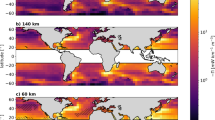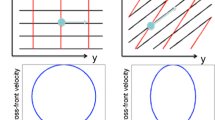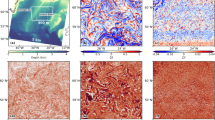Abstract
Wave-wave interactions cause energy cascades. These are the most important processes in the upper ocean because they govern wave-growth and dissipation. Through indirect cascades, wave energy is transferred from higher frequencies to lower frequencies, leading to wave growth. In direct cascades, energy is transferred from lower frequencies to the higher frequencies, which causes waves to break, and dissipation of wave energy. However, the evolution and origin of energy cascade processes are still not fully understood. In particular, for example, results from a recent theory (Kalmykov, 1998) suggest that the class I wave-wave interactions (defined by situations involving 4-, 6-, 8-, etc, even numbers of resonantly interacting waves) cause indirect cascades, and Class II wave-wave interactions (involving, 5-, 7-, 9-, etc,.., odd numbers of waves) cause direct cascades. In contrast to this theory, our model results indicate the 4-wave interactions can cause significant transfer of wave energy through both direct and indirect cascades. In most situations, 4-wave interactions provide the major source of energy transfer for both direct cascades and indirect cascades, except when the wave steepness is larger than 0.28. Our model results agree well with wave measurements, obtained using field buoy data (for example, Lin and Lin, 2002). In particular, in these observations, asymmetrical wave-wave interactions were studied. They found that direct and indirect cascades both are mainly due to the 4-wave interactions when wave steepness is less than 0.3.
Similar content being viewed by others
References
Crawford, D. R., B. M. Lake, P. G. Saffman and H. C. Yuen, 1981. Stability of weakly nonlinear deep-water waves in two and three dimensions,J. Fluid Mech. 105: 177–191.
Hasselmann, S. and K. Hasslemann, 1981. A symmetrical method of computing the nonlinear transfer in a gravity-wave spectrum.Hamb. Geophys. Einzelschriften Reihe A: Wiss. Abhand. 52, 138pp.
Jensen R. E., D. Resio, R. Q. Lin, G. Vledder, T. Herbers and B. Tracy, 1998. A Report of SNL Source function computational workshop in Viskburg. Mississippi, USA.
Kalmykov, V. A., 1998. Energy transfer in the spectrum of surface gravity waves by resonance five wave-wave interactions.Amer. Math. Soc. Transl. 182: 83–94.
Krasitskii, V. P., 1994. On reduced equations in the Hamiltonian theory of weakly non-linear surface waves.J. Fluid Mech. 272: 1–20.
Lin, R. Q. and W. Perrie, 1997. A New Coastal Wave Model, Part 5. Five-wave Interactions.J. of Phys. Ocean. 27: 2169–2186.
Lin, R. Q. and W. Perrie, 1999. Reply.J. of Phys. Ocean. 29: 2113–2116.
Lin, R. Q. and M. Y. Su, 2000. Generating deep water three-dimensional waves by coupling four-wave and five-wave interactions.J. of Geophy. Res. 105(C8): 19739–19744.
Lin, R. Q. and L. Lin, 2002. Asymmetry horse-shoe patterns in observed spectrum. International Workshop on Wave Hindcasting and Prediction, Cannada, Banff. p. 339–351.
Longuet-Higgins, M. S., 1978. The instabilities of gravity waves of finite amplitude in deep water.Proc Roy.Sov. London, Series A 360(1703): 489–505.
McLean, J. W., 1982. Instabilities of finite-amplitude gravity waves on water of finite depth.J. Fluid Mech. 114: 331–341.
Su, M. Y., 1982a. Three dimensional deep-water waves, part I, Experimental measurement of skew and symmetric wave patterns.J. Fluid Mech. 124: 73–108.
Su, M. Y., 1982b. Evolution of groups of gravity waves with moderate to high steepness,Phys. Fluids 25: 2167–2174.
Whitham, G. B., 1974. Linear and Nonlinear Waves. Wiley-Interscience, Chichester, Sussex, UK: pp. 553–563.
Author information
Authors and Affiliations
Corresponding author
Additional information
Supported by grants from the Office of Naval Research under the ILIR program though David Taylor Model Basin, Carderock Division, NSWCCD, and NRL Coastal Ocean Physics Remote Sensing Advanced Research Initiative.
Rights and permissions
About this article
Cite this article
Lin, R.Q., Chubb, S. Energy cascades in the upper ocean. Chin. J. Ocean. Limnol. 24, 225–235 (2006). https://doi.org/10.1007/BF02842621
Received:
Accepted:
Issue Date:
DOI: https://doi.org/10.1007/BF02842621




